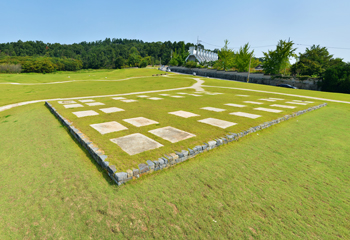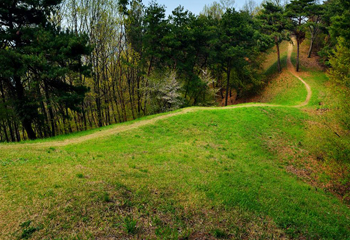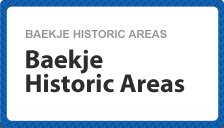Archaeological Site in Gwanbuk-ri and Busosanseong Fortress
The Archaeological Site in Gwanbuk-ri and Busosanseong Fortress were location of the royal palace of the Sabi Period to the north of the current downtown area of Buyeo. It is currently located at the southern foot of Busosan Mountain (106m). The Geumgang River flows around the downtown area from north to west, and then south. To the south of Busosanseong Fortress, a flat terrain in Buyeo was suitable for a location of the royal palace.
Excavation into these sites began in 1980. After more than thirty years of research, most of the structure of the royal palace of Baekje has now been identified.
These sites were proved as the royal palace of baekje for the following reasons:
- A large building site covering 650㎡, regarded as the facilities of the royal palace, was discovered. A gilt-bronze waist belt was unearthed from a temple site at Busosan Mountain, located on a north-south axis from the building site. These findings indicated that the area was once a residential area of kings, as the belt could only have belonged to a king in such a strictly hierarchical society.
- Rooftiles with the insc
ription of the royal court, large stone structures, and the Monument to Liu Renyuan of Tang China were all found around the area, raising the likelihood that it was the site of a royal palace. - The Korean dynasties after the fall of Baekje established local government offices in this area. The structures of buildings constructed during the Baekje Period were reused to build new government offices, thus providing further evidence that the area was the royal palace of Baekje.
Large Building Site

The large building site is regarded as the important building site in the royal palace, presuming from its size (35m wide and 18.5m long) and its structure, which consists of a roof covered with roof tiles. The building loads were supported by pillars erected on cornerstones. A building site of an almost identical size and structure was found at the Archaeological Site in Wanggung-ri, Iksan. The Platform of the large building had two layers, though only 50cm of it now remained. A total of 36 rammed-earth foundations supporting the pillars and cornerstones were also discovered. A square cornerstone, measuring 77cm along each side, was found in the northeast corner of the platform while the other cornerstones have disappeared.
Temple Site of Busosan Mountain
A Buddhist temple site of Baekje is located on the southwestern slope of Busosan Mountain. Archaeological excavation was carried out in 1980, revealing that this temple covered about 3,500㎡. The temple was laid out in the typical “one pagoda, one prayer hall” style, but there are no signs of a lecture hall. While most temple sites dating to the Sabi Period stood on flat land with a slight slope, this temple site was differently situated along the mountain ridge. The temple was built for the royal family, given that well-trimmed stones were used to build the platform, and a gilt-bronze waist belt that would have been used by a person of the highest rank, was found among the archaeological findings.
Water Supply Facilities
Two large wooden water tanks were found. After filtering out impurities from the tanks, water flowed through a 40-meter-long pipe. The tanks had two functions: collecting and supplying water. The pipe connected to the tanks was made by joining two convex roof tiles.
Storage Facilities
Five underground wooden storage facilities, three stone storage facilities, and various pits were found. A wide variety of plant remains was discovered inside the storage facilities, including oriental melons, hardy kiwis, peaches, apricots, dishcloth gourds, and cucumbers, along with an enormous number of oriental melon seeds. The storage facilities were largely used for storing plant-ba
Lotus Pond
Excavation revealed a rectangular pond measuring 10.6m in width by 6.2m in length. It was made by digging a hole 1m to 1.2m deep and piling up five to six layers of stones in the hole. A waterway waterpipe made of tiles, channeling water into the pond, was found in the north of the pond. Inside the pond lotus petals and stems were found.
Busosanseong Fortress

Busosanseong Fortress was located at a rear side of the royal palace. It served as a rear garden during normal times and was used as a defensive structure in the case of an emergency. Busosanseong Fortress was built on Busosan Mountain (106m), which is located in the northernmost point of Buyeo along the Geumgang River to the west. A number of building sites were discovered inside the fortress. Nakhwaam Cliff is located in western end of the fortress.
Archaeological excavations conducted from 1993 to 1994 revealed that the fortress consisted of ramparts made in the Baekje Periods. The fortress had a perimeter of 2,495m, and the bottom layer was 5m to 6m wide and 3m high.
A rammed-earth technique was used to build the walls of the fortress. This technique was also used in constructing Naseong City Wall. The construction work began by erecting supporting trees to prevent the earth from being swept away. The fortress was then built inside these supports by tamping down layers of clay soil and decomposed granite soil, each in turn. In order to prevent the fortress wall from slipping down the steep incline, stone slabs were used to reinforce the stonework. A rammed layer was built inside the central earthwork for extra reinforcement.
The South Gate Site and the East Gate Site, were identified within the fortress. The South Gate was the main gate for the Busosanseong Fortress. Three pit house sites served as barracks in Baekje Periods, were discovered in the southwestern part of the fortress.
Other Archaeological Findings around the Archaeological Site in Gwanbuk-ri and Busosanseong Fortress
The Archaeological Site in Gwanbuk-ri contains diverse structural remains including building sites, roads, stonework and workshops of Baekje. Furthermore, building sites such as stoneworks, water storage facilities, wooden barricades and various other archaeological findings were excavated inside the Busosanseong Fortress, indicating that the fortress was used as a key military ba










